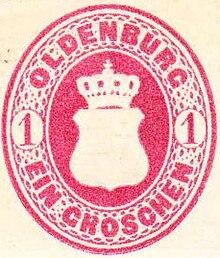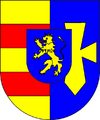Grand Duchy of Oldenburg
|
||||||||||||||||||||||||||||||||||||||||
The Grand Duchy of Oldenburg was a territory that was rebuilt by the Congress of Vienna in 1815 and belonged to the German Confederation . In the German War of 1866 it stood on the side of Prussia and joined the North German Confederation . After that it was a member state in the Empire . On November 11, 1918, the Grand Duke abdicated and the Free State of Oldenburg was created .
history
Restitution of the duchy
After the fall of Napoleon and the end of the Oldenburg French period , Peter Friedrich Ludwig returned to his country from exile in 1814. At the Congress of Vienna in 1815, he was raised to the status of Grand Duchy , but Peter Friedrich Ludwig did not accept the title throughout his life. The national territory consisted of the Duchy of Oldenburg as the heartland and the exclaves of the Principality of Lübeck and the Principality of Birkenfeld an der Nahe . 1818 Oldenburg received the rule Jever by Tsarist Russia Alexander I returned. After the death of Peter Friedrich Ludwig in 1829, his son Paul Friedrich August took over the government and assumed the title of Grand Duke .
Failure of the constitutional monarchy
In the course of the German Revolution , the Basic Law , the first Oldenburg constitution , came into force on February 28, 1849 . It was revised again in 1852. After joining the German-Austrian Postal Union , the first postage stamps of the Grand Duchy of Oldenburg were issued on January 5, 1852 . However, these were not valid in the Principality of Birkenfeld, because this was administered by post by Prussia. In 1853 Nikolaus Friedrich Peter became Grand Duke of Oldenburg. Under his government in 1854 the Kniphausen rule was acquired back.
German unification movement
In 1854 Oldenburg joined the German Customs Union . At the beginning of 1864, the second national Red Cross Society in history was founded in Oldenburg with the Association for the Care of Wounded Warriors . Nikolaus Friedrich Peter took over the patronage of the association.
In the German-Danish War of 1864, Oldenburg was neutral - however, neutrality was violated by the Prussian troops (" storming the Schwartau turnpike ").
In the German War of 1866, Oldenburg troops fought against Austria on the Prussian side . As a result, Oldenburg joined the North German Confederation in 1867 . On January 1, 1868, the Grand Duchy of Oldenburg gave up its own mail shelf . The Oldenburg Infantry Regiment No. 91 and the Oldenburg Dragoon Regiment No. 19 took part in the Franco-German War of 1870/1871. After 47 years of reign, Nikolaus Friedrich Peter died in 1900.
The end of the monarchy
He was succeeded by his son Frederick Augustus , who, however, in the wake of the November Revolution had to give in to public pressure on 11 November 1918 and renounced the throne.
administration
The following administrative structure existed in the Duchy of Oldenburg in 1824:
- Oldenburg district with the city of Oldenburg and the offices of Oldenburg , Elsfleth and Zwischenahn
- Neuchâtel district with the offices of Bockhorn , Rastede , Varel and Westerstede
- District of Ovelgönne with the offices of Abbehausen , Brake , Burhave , Landwürden and Rodenkirchen
- District of Delmenhorst with the offices of Berne , Delmenhorst , Ganderkesee and Wildeshausen
- District of Vechta with the offices of Damme , Steinfeld and Vechta as well as the glory of Dinklage
- District of Cloppenburg with the offices of Cloppenburg , Friesoythe and Löningen
- Rule Jever with the city of Jever and the offices of Jever , Minsen and Tetten
- Lordship of Kniphausen , from 1854 Amt Kniphausen
In 1853 the Jade region was removed from the Jever office and ceded to Prussia . The city of Wilhelmshaven was established in the Jade region .
In 1858 an extensive administrative reform was carried out in the Grand Duchy. Varel became an official city first class. The Zwischenahn office merged with the Westerstede office, the Ganderkesee office with the Delmenhorst office, the Bockhorn office with the Varel office and the Rastede office with the Oldenburg office. The offices of Minsen, Tetten and Kniphausen came to the office of Jever. The Burhave and Abbehausen offices were merged to form the Stollhamm office. The Office Ovelgönne took the place of the Office Rodenkirchen. The division into circles and lordships was not continued.
In 1868 the Rastede office was divided between the offices of Varel and Oldenburg. In 1871 the Steinfeld Office was incorporated into the Damme Office. In a new regional reform in 1879, the number of offices was further reduced. The Löningen office was incorporated into the Cloppenburg office and the Damme office into the Vechta office. The Office Stollhamm became the Office Butjadingen and the Office Berne became the Office Elsfleth. The offices of land dignitaries and Ovelgönne to the office of Brake.
In 1902, the new Rüstringen office was formed from three municipalities of the Jever office . The city of Delmenhorst left the office of Delmenhorst in 1903 and became an office-free city first class. The Oldenburg part of the Grand Duchy thus last had the following territorial division:
Cities I class (unofficial cities)
Offices
- Brake
- Butjadingen
- Cloppenburg
- Delmenhorst
- Elsfleth
- Friesoythe
- Jever
- Oldenburg
- Rüstringen
- Varel
- Vechta
- Westerstede
- Wildeshausen
The three offices existed in the Principality of Birkenfeld
In 1868 the offices in the Principality of Birkenfeld were canceled.
In the Principality of Luebeck passed
- the city of Eutin , as well as the offices
- Eutin
- Grand Bailiwick
- Kaltenhof
- Kollegiatstift .
Since 1843 there were only the offices of Eutin and Schwartau . In 1866, the then Holstein office of Ahrensbök became part of the Principality of Lübeck.
The offices in the Principality of Lübeck were abolished in 1868.
For the organization of the courts, see Courts in the Grand Duchy of Oldenburg .
coat of arms
The coat of arms is a diagonally divided shield, split at the top, split at the bottom by an ascending point. In the first field there are two red crossbars in gold (Oldenburg), in the second in blue a floating golden cross (Delmenhorst), in the third in the blue field a floating golden cross covered with a bishop's hat (Principality of Lübeck), in the fourth a red and white box Field (birch field), at the top in the blue field a golden crowned lion (Jever).
The national colors are blue and red, the flag is blue with a red cross.
Ruling dukes and grand dukes (Gottorp)
| Surname | Domination | Remarks |
|---|---|---|
| Peter Friedrich Ludwig (restituted) | 1813-1829 | Prince Regent since 1785, Duke himself since 1823, Grand Duke de jure since 1815 |
| Paul Friedrich August | 1829-1853 | Acceptance of the Grand Duke title |
| Nikolaus Friedrich Peter | 1853-1900 | |
| Friedrich August II. | 1900-1918 | Abdication as monarch, but still head of the House of Oldenburg |
Minister of State of the Grand Duchy of Oldenburg
The government is managed by the State Ministry. The three ministers were appointed and dismissed by the Grand Duke. The head of government is the president of the entire ministry. The State Ministry directs the administration in the Duchy of Oldenburg and in the two principalities through local administrations.
| Surname | Term of office |
|---|---|
| Karl Ludwig Friedrich Josef von Brandenstein (1760–1847) | October 12, 1814 - June 30, 1842 |
| Günther Heinrich Freiherr von Berg (1765–1843) | 07/01/1842 - 09/09/1843 |
| Wilhelm Ernst Freiherr von Beaulieu-Marconnay (1786-1859) | 09.09.1843 - 01.08.1848 |
| Johann Heinrich Jakob Schloifer (1790–1867) | 08/01/1848 - 08/13/1849 |
| Christian Diedrich von Buttel (1801-1878) | 08/13/1849 - 05/01/1851 |
| Peter Friedrich Ludwig Freiherr von Rössing (1805–1874) | 05/01/1851 - 06/23/1874 |
| Karl von Berg (1810-1894) | 06/23/1874 - 10/01/1876 |
| Friedrich Andreas Ruhstrat (1818-1896) | 10/01/1876 - 03/14/1890 |
| Günther Jansen (1831-1914) | 03/14/1890 - 08/19/1900 |
| Wilhelm Friedrich Willich (1846–1917) | 08/19/1900 - 08/17/1908 |
| Friedrich Julius Heinrich Ruhstrat (1854–1916) | 08/17/1908 - 01/03/1916 |
| Franz Friedrich Paul Ruhstrat (1859–1935) | 03/01/1916 - 06/11/1918 |
currency
The currency in Oldenburg after 1815 and until 1857 was the Reichstaler of 72 Groten of 5 Swars, 1857–1873 the Thaler of 30 Groschen of 12 Pfennigs (also still called Schwaren).
In 1873 the German Reich and with it Oldenburg got the mark as a single currency. A previous thaler was worth 3 marks.
Web links
- Information on the Grand Duchy of Oldenburg in the catalog of the German National Library
- Search for the Grand Duchy of Oldenburg in the German Digital Library
- Search for the Grand Duchy of Oldenburg in the SPK digital portal of the Prussian Cultural Heritage Foundation
literature
- Karl Georg Böse: The Grand Duchy of Oldenburg. Topographical-statistical description of the same. 1863. (Reprint: Wenner, Osnabrück 1979, ISBN 3-87898-147-3 ).
- Albrecht Eckhardt, Heinrich Schmidt (ed.): History of the state of Oldenburg. A manual. Edited on behalf of the Oldenburg landscape. Holzberg, Oldenburg 1987. ISBN 3-87358-285-6 .
- Jörg Michael Henneberg, Horst-Günter Lucke (Hrsg.): History of the Oldenburger Land. Duchy, Grand Duchy, Free State . Edited on behalf of the Oldenburg landscape. Aschendorff, Münster 2014. ISBN 978-3-402-12942-5 .
- Gerhard Köbler : Historical lexicon of the German countries. The German territories from the Middle Ages to the present . 7th edition. Beck, Munich 2007, ISBN 978-3-406-54986-1 (completely revised edition). Online at www.koeblergerhard.de/wikiling .
Individual evidence
- ↑ Oldenburgischer Staats-Kalender 1824. S. 165 ff. , Accessed on July 26, 2020 .
- ^ Uli Schubert: German community register 1910. Accessed on May 22, 2009 .
- ↑ Oldenburg (1820-1914) , accessed on February 19, 2014










